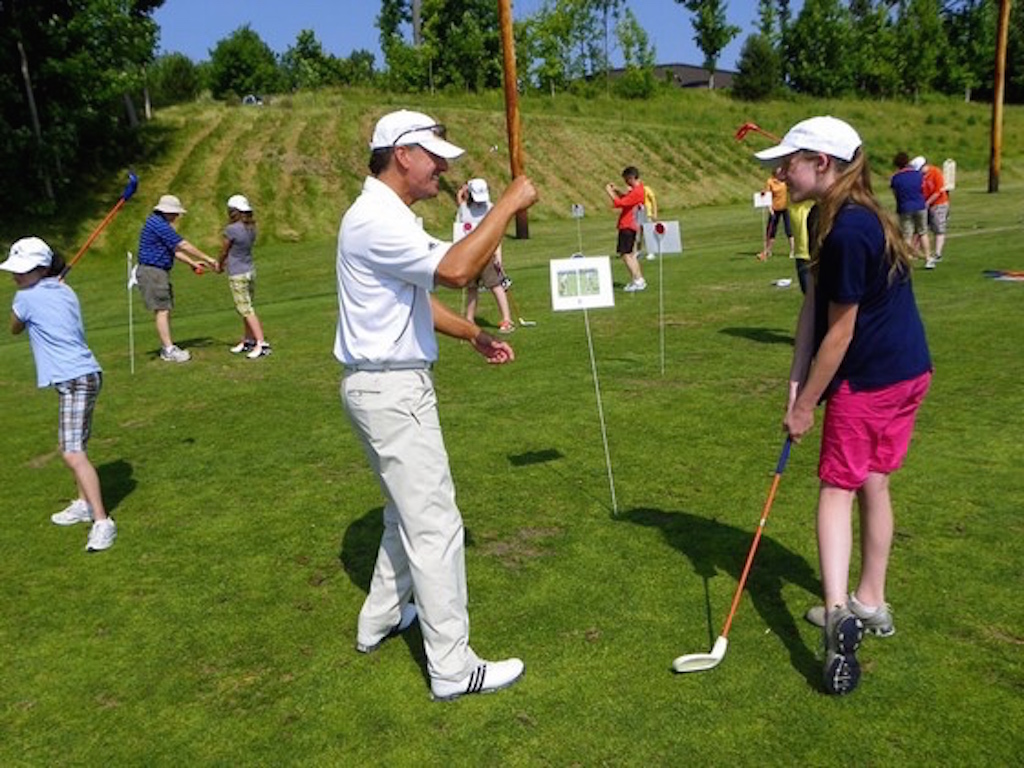Instruction
Proof that you can turn a Deaf ear to golf instruction

[quote_box_center]
“You might just go on to prove that the spoken word is useless in golf instruction.”
– Dr. Jim Suttie
[/quote_box_center]
Dr. Suttie made that statement to me in 2004 when I started the most powerful outreach at my golf academy, and one I’m blessed to be a part of every year.
Now in its 11th year, the U.S. Deaf Golf Camps provide instruction to Deaf children all across America. Thousands of Deaf children have learned the game of golf entirely in their own language — American Sign Language — through our golf academy. I’m lucky to be the only professional doing this on such a large scale anywhere in the world, and yes, I learned Sign Language in order to teach Deaf children the game of golf. We have a lot of fun, and I always say that these camps are “the loudest quiet event in golf!”
Deaf children learn in a unique way, and their focus is different than that of non-hearing  impaired children. Why? Because in Deaf Culture when you sign something, it’s rarely repeated. The eyes of the Deaf student are totally focused on not only what you’re saying, but your body language and expression. They very rarely miss anything you say.
impaired children. Why? Because in Deaf Culture when you sign something, it’s rarely repeated. The eyes of the Deaf student are totally focused on not only what you’re saying, but your body language and expression. They very rarely miss anything you say.
With this in mind, visual learning and any drills or training aids that involve feel are great ways to teach them a golf swing. Because of the limited nature of this instruction, most of the kids that come to the events have zero golf experience swinging a club.
The point that Dr. Suttie made 11 years ago has proven itself in every camp I teach.
Gary Van Sickle of Sports Illustrated said it best. After watching an hour of the camp in Pittsburgh prior to the U.S. Open held in the area that week, he said to me during a break, “You mean to tell me that none of these kids have ever swung a club? This is amazing to see how good these swings are after an hour!”
So how do I make the spoken word useless and how does it help your game?
The main visual way I teach these kids is using what I call the “Circle of Seven.” I have seven poles, and Velcroed onto each pole is a picture of a posed position in the golf swing. Each picture represents a place in the swing that is important for the player to pass through. The kids rotate from picture-to-picture, posing to match the different positions. I go around and approve their poses, or give them some easy cues to pose correctly. When they have all met my standard for the poses, they rotate to the next image and repeat the process.
After doing this for all seven images, I bring the children together and spread them out all around me. We then drill the positions into their memory. On my command, I sign a number that represents a position from the pictures, and they all pose in the position. I say numbers in random order so that they have to think out of order at first. Eventually, I roll it all together sequentially and they move from setup to finish, and a golf swing is the final product.
I have always thought that your swing can only be as good as you can model, or pose, the places the swing passes through. If you struggle to model a certain position, there may be a physical limitation, which we work around.
Here are the pictures that the kids see on the poles:
We can all learn a proper golf swing using this formula.
I suggest that you print a couple of the poses out, or pick one you struggle with. For the summer, spend some time each day with a club and just practice stopping in that position and holding for 10 seconds (you can even flip the image and make it like you are looking in a mirror if that helps). Try to get a feel for it.
This is not muscle memory, because there is no such thing! Muscles cannot remember because they do not have brain cells — but they can feel. What you’re trying to do is recreate feelings, and have those balanced feeling motions ingrained by repetition. I have seen some great swings grow out of this visual mirroring technique. It’s happened time and again in just one morning session with Deaf children all across the U.S. for the last 11 years!
Watch the video below to get a glimpse of what the U.S. Deaf Golf Camps are all about.
- LIKE65
- LEGIT2
- WOW1
- LOL0
- IDHT0
- FLOP0
- OB0
- SHANK0
Instruction
Clement: Laid-off or perfect fade? Across-the-line or perfect draw?

Some call the image on the left laid off, but if you are hitting a fade, this could be a perfect backswing for it! Same for across the line for a draw! Stop racking your brain with perceived mistakes and simply match backswing to shot shape!
- LIKE0
- LEGIT0
- WOW0
- LOL0
- IDHT0
- FLOP0
- OB0
- SHANK1
Instruction
The Wedge Guy: The easiest-to-learn golf basic

My golf learning began with this simple fact – if you don’t have a fundamentally sound hold on the golf club, it is practically impossible for your body to execute a fundamentally sound golf swing. I’m still a big believer that the golf swing is much easier to execute if you begin with the proper hold on the club.
As you might imagine, I come into contact with hundreds of golfers of all skill levels. And it is very rare to see a good player with a bad hold on the golf club. There are some exceptions, for sure, but they are very few and very far between, and they typically have beat so many balls with their poor grip that they’ve found a way to work around it.
The reality of biophysics is that the body moves only in certain ways – and the particulars of the way you hold the golf club can totally prevent a sound swing motion that allows the club to release properly through the impact zone. The wonderful thing is that anyone can learn how to put a fundamentally sound hold on the golf club, and you can practice it anywhere your hands are not otherwise engaged, like watching TV or just sitting and relaxing.
Whether you prefer an overlap, interlock or full-finger (not baseball!) grip on the club, the same fundamentals apply. Here are the major grip faults I see most often, in the order of the frequency:
Mis-aligned hands
By this I mean that the palms of the two hands are not parallel to each other. Too many golfers have a weak left hand and strong right, or vice versa. The easiest way to learn how to hold the club with your palms aligned properly is to grip a plain wooden ruler or yardstick. It forces the hands to align properly and shows you how that feels. If you grip and re-grip a yardstick several times, then grip a club, you’ll see that the learning curve is almost immediate.
The position of the grip in the upper/left hand
I also observe many golfers who have the butt of the grip too far into the heel pad of the upper hand (the left hand for right-handed players). It’s amazing how much easier it is to release the club through the ball if even 1/4-1/2″ of the butt is beyond the left heel pad. Try this yourself to see what I mean. Swing the club freely with just your left hand and notice the difference in its release from when you hold it at the end of the grip, versus gripping down even a half inch.
To help you really understand how this works, go to the range and hit shots with your five-iron gripped down a full inch to make the club the same length as your seven-iron. You will probably see an amazing shot shape difference, and likely not see as much distance loss as you would expect.
Too much lower (right) hand on the club
It seems like almost all golfers of 8-10 handicap or higher have the club too far into the palm of the lower hand, because that feels “good” if you are trying to control the path of the clubhead to the ball. But the golf swing is not an effort to hit at the ball – it is a swing of the club. The proper hold on the club has the grip underneath the pad at the base of the fingers. This will likely feel “weak” to you — like you cannot control the club like that. EXACTLY. You should not be trying to control the club with your lower/master hand.
Gripping too tightly
Nearly all golfers hold the club too tightly, which tenses up the forearms and prevents a proper release of the club through impact. In order for the club to move back and through properly, you must feel that the club is controlled by the last three fingers of the upper hand, and the middle two fingers of the lower hand. If you engage your thumbs and forefingers in “holding” the club, the result will almost always be a grip that is too tight. Try this for yourself. Hold the club in your upper hand only, and squeeze firmly with just the last three fingers, with the forefinger and thumb off the club entirely. You have good control, but your forearms are not tense. Then begin to squeeze down with your thumb and forefinger and observe the tensing of the entire forearm. This is the way we are made, so the key to preventing tenseness in the arms is to hold the club very lightly with the “pinchers” — the thumbs and forefingers.
So, those are what I believe are the four fundamentals of a good grip. Anyone can learn them in their home or office very quickly. There is no easier way to improve your ball striking consistency and add distance than giving more attention to the way you hold the golf club.
More from the Wedge Guy
- The Wedge Guy: Golf mastery begins with your wedge game
- The Wedge Guy: Why golf is 20 times harder than brain surgery
- The Wedge Guy: Musings on the golf ball rollback
- LIKE88
- LEGIT14
- WOW6
- LOL1
- IDHT0
- FLOP4
- OB1
- SHANK8
Instruction
Clement: Stop ripping off your swing with this drill!

Not the dreaded headcover under the armpit drill! As if your body is defective and can’t function by itself! Have you seen how incredible the human machine is with all the incredible feats of agility all kinds of athletes are accomplishing? You think your body is so defective (the good Lord is laughing his head off at you) that it needs a headcover tucked under the armpit so you can swing like T-Rex?
- LIKE0
- LEGIT2
- WOW2
- LOL0
- IDHT0
- FLOP0
- OB0
- SHANK2
-

 19th Hole3 weeks ago
19th Hole3 weeks agoDave Portnoy places monstrous outright bet for the 2024 Masters
-

 19th Hole1 week ago
19th Hole1 week agoJustin Thomas on the equipment choice of Scottie Scheffler that he thinks is ‘weird’
-

 19th Hole1 week ago
19th Hole1 week ago‘Absolutely crazy’ – Major champ lays into Patrick Cantlay over his decision on final hole of RBC Heritage
-

 19th Hole2 weeks ago
19th Hole2 weeks agoTwo star names reportedly blanked Jon Rahm all week at the Masters
-

 19th Hole2 weeks ago
19th Hole2 weeks agoReport: LIV Golf identifies latest star name they hope to sign to breakaway tour
-

 19th Hole2 weeks ago
19th Hole2 weeks agoNeal Shipley presser ends in awkward fashion after reporter claims Tiger handed him note on 8th fairway
-

 19th Hole2 weeks ago
19th Hole2 weeks agoBrandel Chamblee has ‘no doubt’ who started the McIlroy/LIV rumor and why
-

 Equipment3 weeks ago
Equipment3 weeks agoWhat we know about Bryson DeChambeau’s 3D-printed Avoda irons
























tbag
May 11, 2015 at 10:53 pm
Being hearing impaired, it is a great gift these kids are receiving. Teaching is returning a gift you received once. What a great statement of love of the game of golf.
Al
May 10, 2015 at 10:33 am
Golf instruction, by spoken or written word, reminds me of learning magic from books. After the move/s are mastered, the instruction makes perfect sense.
RG
May 8, 2015 at 2:06 am
Great article. Deaf children epitomize visual learning. Those of us with hearing could learn a lot from them. What’s that you ask? Be quiet and focus on what your seeing. Realize that you can’t talk yourself into a good shot, you have to visualize it and execute.
Philip
May 7, 2015 at 11:16 pm
Very enlightening, thank you
GDP
May 7, 2015 at 10:14 am
Great read. I’m gonna use your pictures! Thanks.
Greg V
May 7, 2015 at 9:37 am
That was a very interesting article, and food for thought.
Thanks.